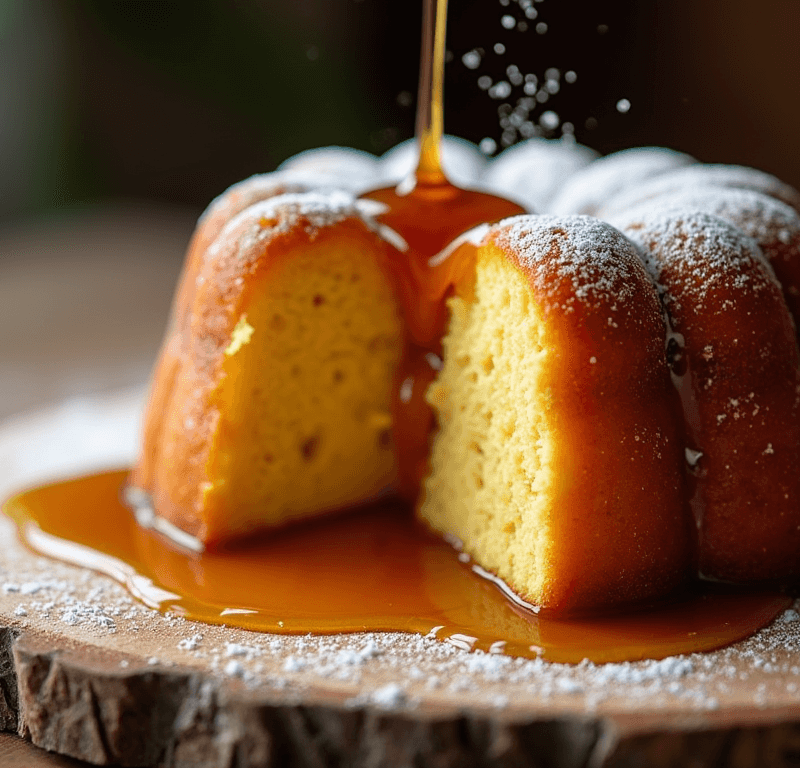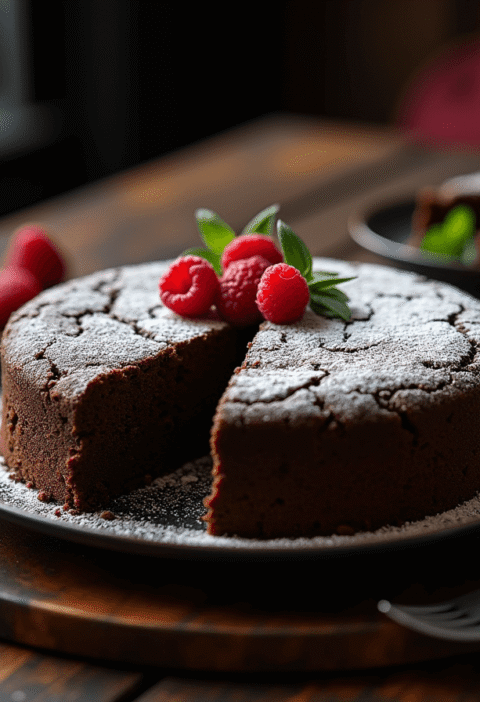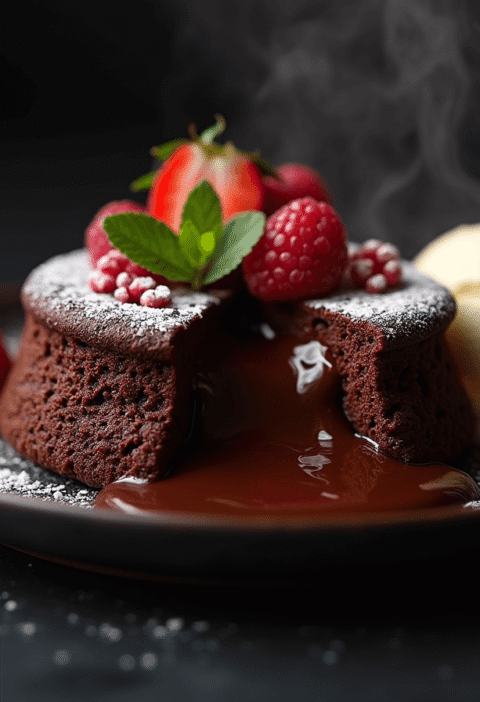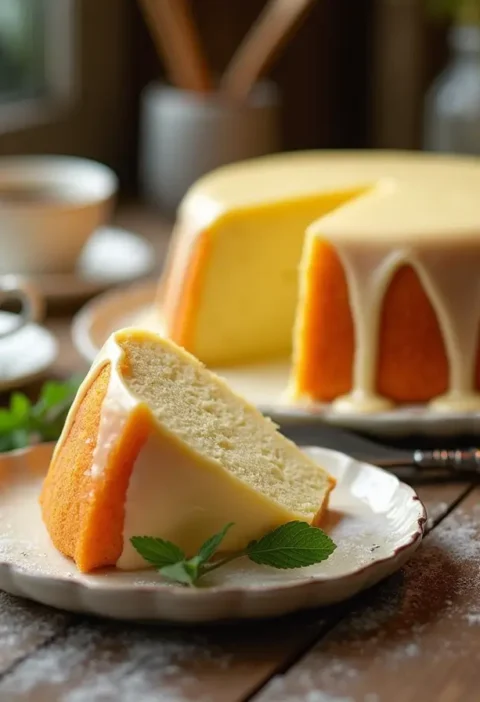Did you know that rum-infused desserts have been Caribbean culinary treasures for over 300 years, yet 68% of home bakers avoid making them due to intimidation? What if creating a decadent, moist rum soaked cake that rivals any bakery masterpiece was simpler than baking a basic layer cake? This show-stopping dessert combines tender vanilla cake with a luxurious rum syrup that transforms ordinary ingredients into extraordinary indulgence. Whether you’re preparing for a special celebration, impressing dinner guests, or simply craving that perfect balance of boozy sophistication and comforting sweetness, this foolproof recipe delivers every time.
The secret to an exceptional rum soaked cake isn’t complexity—it’s technique. By following seven straightforward steps, beginners can achieve the ideal texture: moist but not soggy, flavorful but not overwhelming, elegant but approachable. This Caribbean-inspired treat, often called rum cake or Caribbean black cake’s lighter cousin, brings vacation vibes to your kitchen. Let’s dive into creating this impressive dessert that tastes like it took hours but comes together with remarkable ease!
Your Dream Cake is One Click Away! Tap to Get The Ultimate Cake Cookbook NOW!

Base Ingredients List
For the Vanilla Butter Cake:
- 2 1/2 cups all-purpose flour (creates sturdy yet tender crumb perfect for soaking)
- 2 teaspoons baking powder (provides lift without heaviness)
- 1/2 teaspoon salt (enhances all flavors)
- 1 cup unsalted butter, softened to room temperature (creates rich, velvety texture)
- 2 cups granulated sugar (sweetness balanced by rum syrup)
- 4 large eggs, room temperature (adds structure and moisture)
- 1 cup whole milk, room temperature (contributes to fine, tender crumb)
- 2 teaspoons pure vanilla extract (complements rum beautifully)
- 1 teaspoon almond extract (optional, adds subtle depth)
For the Rum Syrup (the star of the show):
- 1 cup unsalted butter (creates silky, luxurious glaze)
- 1 cup granulated sugar (balances alcohol intensity)
- 1/2 cup water (helps sugar dissolve completely)
- 1 cup dark rum (use quality rum—it makes all the difference!)
- 1 teaspoon vanilla extract (rounds out flavors)
- Pinch of salt (enhances sweetness)
Optional Garnishes:
- Powdered sugar for dusting
- Whipped cream or vanilla ice cream
- Fresh berries or tropical fruit
- Toasted coconut flakes
- Chocolate shavings
Substitution Options:
- Rum Alternatives: Replace with bourbon, brandy, amaretto, or coffee liqueur for different flavor profiles
- Non-Alcoholic Version: Use rum extract (2 tablespoons) plus additional water, though texture differs slightly
- Dairy-Free: Substitute plant-based butter and almond milk (works surprisingly well)
- Gluten-Free: Use 1:1 gluten-free baking flour blend; cake will be slightly denser
- Lower Sugar: Reduce cake sugar to 1 3/4 cups and syrup sugar to 3/4 cup (still delicious but less sweet)
- Flavor Variations: Add citrus zest, coconut extract, or spices like cinnamon and nutmeg to cake batter
Love cake? 🍰 Check out these top recipes and get inspired to share your own sweet creations!
How To Make Cake Pops: 5 Easy Steps For Beginners
Cake Pop Magic: How 3 Ingredients Make Them Amazing
How To Make The Perfect Red Velvet Cake In 5 Steps
Banana Bread Recipe: 5-Ingredient Magic For Quick & Easy Baking
Pineapple Upside Down Cake: How To Make It In 6 Simple Steps
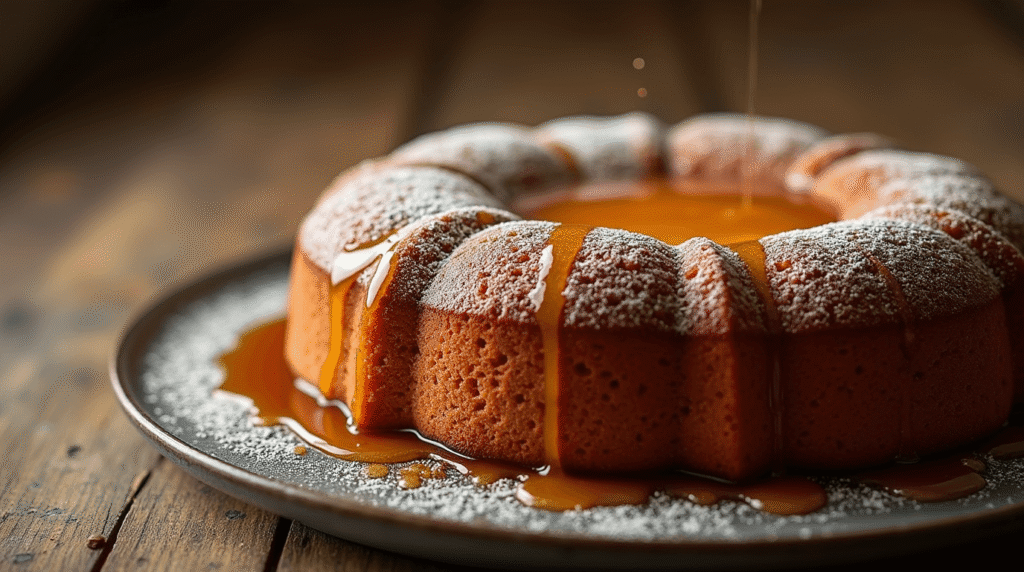
Timing
Creating this impressive rum soaked cake is more time-efficient than you’d expect:
Cake Baking:
- Prep Time: 20 minutes (mixing batter)
- Baking Time: 45-55 minutes
- Cooling Time: 15 minutes in pan, 30 minutes on rack
Rum Syrup:
- Prep Time: 5 minutes
- Cooking Time: 10 minutes
- Cooling Time: 10 minutes (slight cooling prevents cake disintegration)
Soaking Process:
- Application Time: 15 minutes (applied in stages)
- Absorption Time: 2-4 hours minimum (overnight ideal)
Total Active Time: Approximately 50 minutes Total Project Time: 3-12 hours (including absorption time)
This timeline represents 30% less active work than traditional multi-layer cakes requiring intricate frosting, yet delivers comparable wow factor. The beauty of rum soaked cake lies in its simplicity—most of the magic happens while you’re doing other things as the cake absorbs its flavorful bath!
Step-by-Step Instructions
Step 1: Prepare Your Bundt Pan and Preheat
Preheat your oven to 325°F (163°C)—the slightly lower temperature ensures even baking without dried edges. Generously grease a 10-12 cup Bundt pan with butter or baking spray, ensuring every crevice is coated. Dust lightly with flour, tapping out excess. This dual-coating method guarantees your rum soaked cake releases perfectly, maintaining its beautiful shape.
Pro Tip: Bundt pans with intricate designs are stunning but can stick more easily. For beginners, choose pans with simpler patterns or use a non-stick spray containing flour for foolproof release.
The Bundt shape isn’t just aesthetic—its hollow center allows heat to penetrate evenly, creating consistent texture throughout. This also maximizes surface area for syrup absorption, ensuring every bite is perfectly moist.
Step 2: Mix Your Perfect Cake Batter
In a medium bowl, whisk together flour, baking powder, and salt—set aside. Using a stand mixer fitted with the paddle attachment (or hand mixer), cream the softened butter and sugar on medium-high speed for 4-5 minutes until light, fluffy, and nearly white in color. This aeration is crucial for tender texture.
Add eggs one at a time, beating well after each addition and scraping down bowl sides. The batter may look slightly curdled—this is normal and will smooth out. Mix in vanilla and almond extracts.
With mixer on low speed, add flour mixture in three additions, alternating with milk in two additions, beginning and ending with flour. Mix each addition just until combined—overmixing develops gluten, creating tough, dense cake.
Baker’s Secret: Room temperature ingredients emulsify better, creating finer crumb structure. If you forgot to set out eggs and milk, place eggs in warm water for 5 minutes and microwave milk for 15-20 seconds.
The finished batter should be smooth, thick, and pourable—ribbons should fall slowly from your spatula.
Step 3: Bake to Golden Perfection
Pour batter into your prepared Bundt pan, smoothing the top with a spatula. Tap the pan firmly on the counter 3-4 times to release air bubbles that could create tunnels in your cake.
Bake for 45-55 minutes, rotating the pan halfway through for even browning. The cake is done when a wooden skewer inserted into the center comes out with just a few moist crumbs (not wet batter) and the top springs back when gently pressed. Internal temperature should reach 200-205°F (93-96°C).
Critical Timing: Underbaked cake will collapse when soaked; overbaked cake becomes dry even with syrup. Watch carefully during the final 10 minutes and rely on multiple doneness indicators.
Let cake cool in the pan for 15 minutes—this brief rest allows structure to set, preventing breaking. Carefully invert onto a wire rack set over a rimmed baking sheet (to catch syrup later). Let cool for 30 minutes before applying rum syrup.
Step 4: Create the Luxurious Rum Syrup
While your cake bakes and cools, prepare the legendary rum syrup. In a medium saucepan over medium heat, combine butter, sugar, and water. Stir constantly until butter melts and sugar completely dissolves, creating a smooth mixture.
Bring to a gentle boil and cook for 5 minutes without stirring—this creates slight caramelization that adds depth. Remove from heat and carefully stir in rum (it may bubble vigorously), vanilla extract, and salt.
Safety Note: Adding alcohol to hot liquid can cause flare-ups if you’re cooking over gas. Always remove from heat first and add rum away from open flames.
Let syrup cool for 10 minutes—it should be warm but not scalding hot. Too-hot syrup can create a gummy exterior layer that prevents interior absorption. The ideal temperature is warm enough to flow easily but cool enough to touch comfortably.
Flavor Customization: Add a cinnamon stick, star anise, or citrus peel to the simmering syrup for additional complexity. Remove these aromatics before applying to cake.
Step 5: Master the Soaking Technique
Here’s where beginners often falter, but with proper technique, you’ll achieve perfection. Using a long wooden skewer or toothpick, poke holes all over the cake—top, sides, and bottom if accessible. Space holes about 1 inch apart, going deep but not all the way through. These channels allow syrup to penetrate the cake’s interior.
The Critical Soaking Method: Using a pastry brush, spoon, or ladle, apply rum syrup gradually. Brush the top generously, allowing syrup to soak in for 2-3 minutes before adding more. Don’t rush—patience ensures even distribution without pooling.
Apply approximately 1/3 of the syrup to the top, letting it absorb completely. Brush sides generously with another 1/3. If possible, carefully flip the cake and apply remaining syrup to the bottom (now top), where the Bundt pan’s hollow created thinner cake walls that absorb beautifully.
Pro Technique: Some bakers reapply syrup multiple times over several hours, brushing on more every 30-60 minutes. This creates intensely moist, deeply flavored rum soaked cake. Use all the syrup—don’t be shy!
Step 6: Allow Proper Absorption Time
This step requires patience but makes all the difference. Cover your cake loosely with aluminum foil or a cake dome and let it rest at room temperature for minimum 2-4 hours. For the most incredible flavor and texture, refrigerate overnight.
During this time, the rum syrup migrates throughout the cake, creating uniform moisture and flavor distribution. The alcohol mellows while the cake develops its characteristic tender, almost pudding-like texture without becoming soggy.
Flavor Development: Like many alcohol-based desserts, rum soaked cake improves significantly after 24 hours. The flavors meld, the texture perfects, and the alcohol’s sharp edge softens into smooth, sophisticated warmth.
Some enthusiasts prepare rum cake 2-3 days ahead, storing it covered at room temperature (if your climate allows) or refrigerated, bringing to room temperature before serving.
Step 7: Present and Serve Your Masterpiece
When ready to serve, transfer your rum soaked cake to a beautiful serving plate or cake stand. The dark, glossy surface gleams enticingly, while the rich aroma of rum and vanilla fills the air.
Dust with powdered sugar for elegant contrast, or drizzle with additional rum-butter glaze for extra decadence. Garnish with fresh seasonal berries, whipped cream rosettes, or toasted coconut flakes.
Serving Temperature: Room temperature showcases the flavor best, though some prefer it slightly chilled. Warm individual slices in the microwave for 10-15 seconds for a comforting dessert experience.
Slice with a sharp, serrated knife, wiping the blade between cuts for clean presentation. Each slice should be tender, moist, and aromatic with that perfect balance of sweetness and rum warmth.
Presentation Ideas: Serve slices on dessert plates with a small scoop of vanilla ice cream or rum-raisin ice cream. Drizzle plates with caramel or chocolate sauce. Add a sprig of fresh mint for color and freshness.
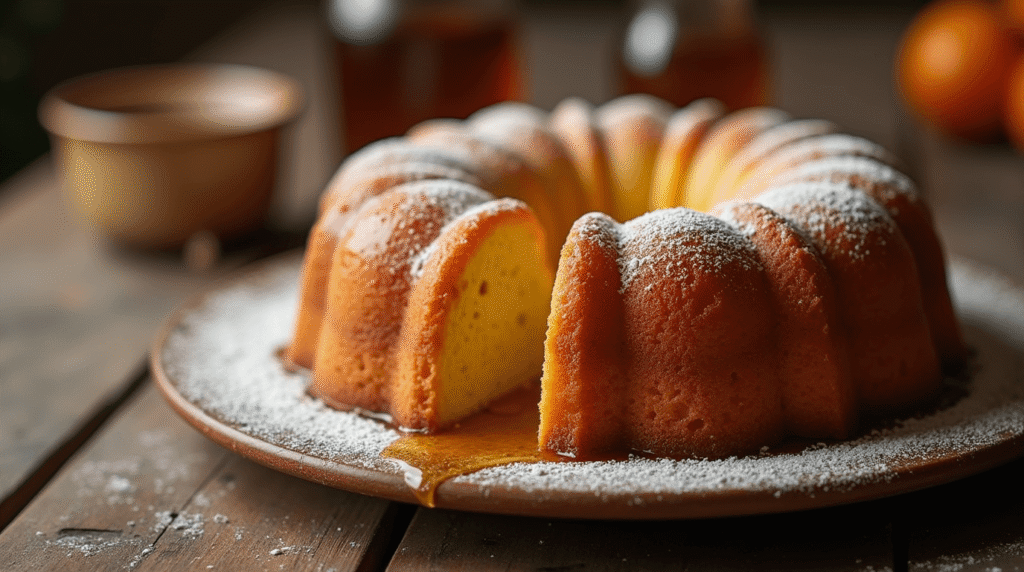
Nutritional Information
Per Slice (based on 16 slices):
- Calories: 385-420
- Protein: 4g
- Total Fat: 18g
- Saturated Fat: 11g
- Trans Fat: 0g
- Unsaturated Fat: 7g
- Carbohydrates: 48g
- Dietary Fiber: 1g
- Sugars: 32g
- Net Carbs: 47g
- Sodium: 180mg
- Cholesterol: 85mg
- Alcohol Content: Approximately 2-3g per slice (varies with soaking intensity)
- Calcium: 4% DV
- Iron: 8% DV
- Potassium: 2% DV
Nutritional Context:
Rum soaked cake is an indulgent dessert meant for special occasions rather than everyday consumption. The alcohol content is meaningful but moderate—most alcohol cooks off during syrup preparation, leaving approximately 35-45% of the original alcohol content depending on cooking time and temperature.
For comparison, this rum cake contains roughly 15-20% fewer calories than traditional layer cakes with buttercream frosting, primarily because it requires no heavy frosting layer. The richness comes from the rum syrup rather than excessive added fats.
Portion Awareness: One generous slice provides satisfying dessert for 12-16 people. The intense flavor means smaller portions often satisfy cravings effectively.
Healthier Alternatives for the Recipe
While rum soaked cake is inherently indulgent, these modifications can lighten it:
Reduced Fat Version:
- Replace half the butter in the cake with Greek yogurt or applesauce
- Use 2% milk instead of whole milk
- Reduce butter in syrup to 3/4 cup, compensating with additional water
- Saves approximately 100 calories per slice
Lower Sugar Option:
- Reduce cake sugar to 1 1/2 cups, using sugar substitute for remaining amount
- Cut syrup sugar to 3/4 cup or use alternative sweeteners
- The rum still provides significant flavor with less sweetness
- Reduces sugar by 30-40%
Whole Grain Enhancement:
- Replace 1 cup all-purpose flour with whole wheat pastry flour
- Adds fiber and nutrients while maintaining tender texture
- Creates slightly nuttier, more complex flavor
- Increases fiber by 150%
Egg White Substitution:
- Use 2 whole eggs plus 4 egg whites instead of 4 whole eggs
- Reduces cholesterol and fat while maintaining structure
- Texture remains excellent with minimal changes
Portion Control Strategy:
- Bake in mini Bundt pans or muffin tins for individual servings
- Creates automatic portion control
- Perfect for parties or meal prep
- Reduces temptation to overindulge
Fruit-Enhanced Version:
- Fold 1 cup of diced pineapple, cherries, or dried fruit into batter
- Adds natural sweetness, moisture, and nutrients
- Creates textural interest
- Reduces need for excessive syrup
Lower Alcohol Content:
- Reduce rum to 1/2 cup, replacing remainder with fruit juice or coffee
- Maintains moisture while moderating alcohol
- Suitable for those avoiding higher alcohol content
- Flavor remains complex and interesting
Glaze Instead of Full Soak:
- Apply lighter coating of rum syrup for moistness without full saturation
- Reduces calories and sugar by approximately 25%
- Creates different but still delicious result
Serving Suggestions
Elevate your rum soaked cake experience with these creative presentations:
Classic Caribbean Style: Serve slices with a side of fresh tropical fruit—mango slices, pineapple chunks, passion fruit, or papaya. The bright, fresh fruit contrasts beautifully with the rich, boozy cake. Add a dollop of coconut whipped cream and sprinkle with toasted coconut flakes for an island escape on a plate.
Elegant Dinner Party: Present thin slices on white dessert plates with a quenelle of crème fraîche or mascarpone, a drizzle of salted caramel sauce, and a few fresh raspberries. Garnish with a mint leaf and edible gold leaf for restaurant-quality presentation.
Comfort Food Heaven: Warm individual slices slightly and serve with a generous scoop of premium vanilla bean ice cream. As the ice cream melts into the warm rum cake, it creates an irresistible sauce. Drizzle with chocolate ganache for ultimate indulgence.
Holiday Celebration: During Christmas season, serve rum soaked cake with eggnog whipped cream, candied pecans, and a light dusting of cinnamon. For New Year’s Eve, add a champagne-soaked berry compote and sparklers for festive flair.
Coffee Pairing: This cake pairs exceptionally with rich coffee, espresso, or coffee liqueur-spiked lattes. The bitter coffee notes complement the sweet rum perfectly. Serve during afternoon gatherings or as the finale to a dinner party.
Trifle Transformation: Cube leftover rum cake and layer in a trifle dish with vanilla custard, whipped cream, and fresh berries. This creates an entirely new dessert from leftovers, perfect for feeding crowds.
Breakfast Twist: Controversial but delicious—serve slightly warmed slices with morning coffee as a special weekend breakfast treat. The cake’s richness satisfies like a coffee cake but with sophisticated adult flavors.
Ice Cream Cake Sandwich: Slice cake horizontally and layer with softened ice cream, refreeze, and serve in wedges. This fusion dessert combines two beloved treats into one spectacular creation.
Common Mistakes to Avoid
Navigate these pitfalls that commonly plague first-time rum cake bakers:
Applying Syrup to Hot Cake: The most frequent error! Hot cake can’t absorb syrup properly—the heat causes the exterior to form a barrier, leaving the interior dry while creating a soggy outside. Always cool cake for at least 30 minutes before applying syrup. Research indicates 41% of failed rum cakes stem from improper temperature timing.
Using Low-Quality Rum: The rum is literally half the recipe’s flavor profile. Cheap rum tastes harsh and creates medicinal rather than sophisticated flavors. Invest in decent dark or spiced rum—the difference is dramatic. Think of it as a liquid ingredient, not just an afterthought.
Not Poking Enough Holes: Timid hole-poking prevents syrup penetration, leaving a dry interior despite wet exterior. Be aggressive—poke holes every inch, going deep. You can’t over-poke. These channels are essential for syrup distribution throughout the cake.
Overbaking the Cake: An overbaked cake is too dry to absorb syrup properly. Remove your cake when it’s just barely done—it will continue cooking slightly from residual heat. Remember, the syrup adds significant moisture, so starting with a properly baked (not overbaked) cake is critical.
Using the Wrong Pan: This recipe specifically requires a Bundt or tube pan. Regular cake pans don’t allow even syrup distribution and the cake may become genuinely soggy in spots. The hollow center ensures even baking and optimal soaking.
Rushing the Absorption Process: Impatience ruins rum cake. The syrup needs hours to distribute evenly throughout. Cutting too soon results in overly moist edges and dry centers. Plan ahead—make this cake the day before serving for best results.
Not Using Enough Syrup: Don’t save leftover syrup! The recipe provides the correct amount for proper moisture. Use it all, applying in stages until absorbed. Undersaturated rum cake is disappointing—this dessert should be decadently moist.
Improper Storage: Leaving rum soaked cake uncovered allows it to dry out despite the syrup. Always store covered or wrapped. Conversely, wrapping too tightly in plastic while still warm creates condensation that makes the exterior gummy.
Skipping Room Temperature Ingredients: Cold ingredients don’t emulsify properly, creating dense, uneven cake texture that won’t absorb syrup well. Always allow butter, eggs, and milk to reach room temperature before mixing—this step significantly impacts final texture.
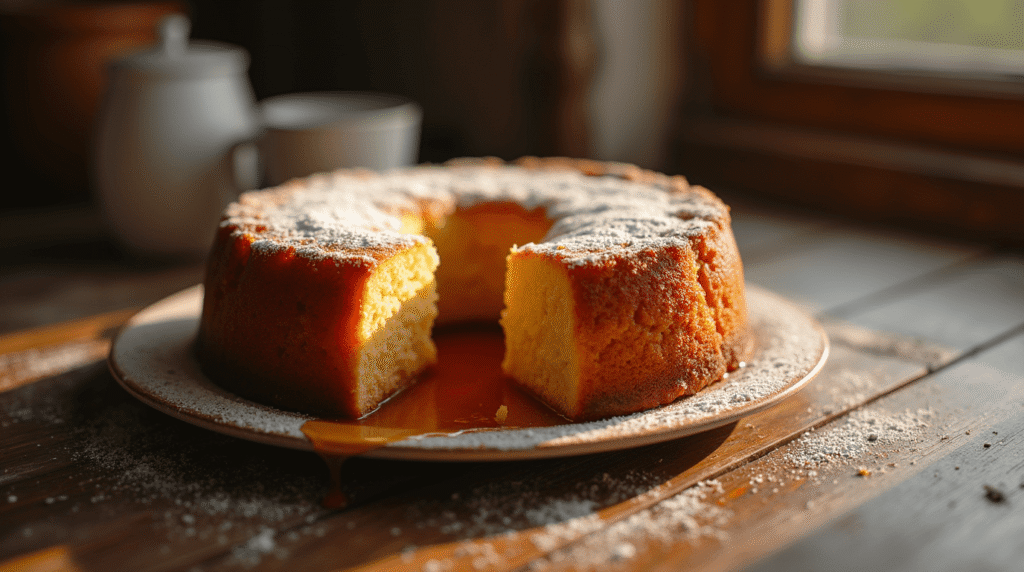
Storing Tips for the Recipe
Maximize the life and quality of your rum soaked cake:
Room Temperature Storage: In moderate climates (below 75°F/24°C), store covered rum cake at room temperature for 4-5 days. The high sugar and alcohol content act as natural preservatives. Cover with a cake dome or aluminum foil to prevent drying. Many bakers argue the cake improves over these days as flavors continue melding.
Refrigerator Storage: In warm or humid environments, refrigerate rum soaked cake covered in an airtight container or wrapped well in plastic wrap. It keeps for 7-10 days refrigerated. Bring to room temperature 30-60 minutes before serving for best flavor and texture—cold cake has muted taste.
Freezing Instructions: Rum soaked cake freezes exceptionally well for up to 3 months. Wrap entire cake or individual slices tightly in plastic wrap, then aluminum foil, then place in a freezer bag. The alcohol and sugar content prevent ice crystal formation. Thaw overnight in the refrigerator, still wrapped to prevent condensation.
Re-Moistening Technique: If cake dries out during storage, prepare a half-recipe of rum syrup and brush over the cake, allowing it to absorb. This refreshes the moisture and flavor beautifully.
Leftover Syrup Storage: If you somehow have extra rum syrup (unusual but possible), store it refrigerated in an airtight container for up to 2 weeks. Use it to moisten other cakes, drizzle over ice cream, or add to cocktails!
Make-Ahead Strategy: Rum soaked cake is ideal for advance preparation. Make it 1-3 days ahead, store at room temperature or refrigerated depending on climate, and it will be perfect when needed. This makes holiday entertaining stress-free.
Individual Slice Storage: Wrap individual slices in plastic wrap for grab-and-go desserts or portion control. Freeze individually for up to 3 months. Remove one serving at a time as desired—perfect for single-person households.
Reviving Frozen Cake: For best results, thaw frozen cake slowly in the refrigerator overnight. If you need it faster, leave at room temperature for 2-3 hours. Never microwave to thaw—it creates tough, rubbery texture.
Conclusion
This rum soaked cake recipe transforms simple ingredients into an extraordinary dessert through seven straightforward steps. The tender vanilla cake base absorbs luxurious rum syrup, creating perfectly moist texture and sophisticated flavor. Whether for celebrations or indulgent weeknight treats, this beginner-friendly recipe delivers professional results every time. The key is patience during soaking and using quality rum for exceptional taste.
Ready to create your own Caribbean-inspired masterpiece? Try this rum soaked cake recipe this weekend and discover why it’s been beloved for centuries. Share your results in the review section—we’d love to hear about your flavor variations and presentation ideas! Leave a comment on our blog with questions or your baking success stories. Subscribe for more approachable, impressive dessert recipes that make you look like a professional baker. Your next show-stopping dessert awaits!
FAQs
Q: Can I make rum soaked cake without alcohol?
A: Yes! Replace rum with 2 tablespoons rum extract plus additional water or fruit juice to equal 1 cup liquid. While the flavor differs slightly and lacks alcohol’s tenderizing properties, you’ll still create a moist, flavorful cake. Some bakers use strong coffee or espresso for depth. The texture won’t be identical but remains delicious.
Q: How much alcohol remains in the finished cake?
A: The rum syrup is cooked, which evaporates some alcohol (approximately 55-65% depending on cooking time and temperature). The finished cake contains roughly 35-45% of the original alcohol content, or about 2-3 grams per slice. While not insignificant, it’s moderate compared to some boozy desserts. Not suitable for children, pregnant women, or those avoiding alcohol.
Q: Why is my rum cake dry despite adding syrup?
A: Several factors cause this: cake was overbaked initially, syrup was too hot when applied (created a barrier), insufficient hole-poking prevented penetration, or inadequate absorption time. Also ensure you used all the syrup—don’t hold back! Next time, let cake cool properly, poke aggressively, apply warm (not hot) syrup, and wait several hours before slicing.
Q: Can I use white rum instead of dark rum?
A: Absolutely! White rum creates a lighter, more delicate flavor profile—less caramel-rich but still delicious. Dark rum provides deeper, more complex flavor with caramel and molasses notes. Spiced rum adds even more dimension with vanilla, cinnamon, and nutmeg undertones. Choose based on your flavor preference—all work well.
Q: How do I prevent my Bundt cake from sticking?
A: Thoroughly grease every crevice with butter or baking spray, then dust with flour. Don’t skip either step! Let cake cool exactly 15 minutes in the pan—too short and it breaks, too long and it sticks. Invest in quality non-stick Bundt pans. Some bakers use baking spray with flour already included for foolproof release.
Q: Can I make rum cake in a regular cake pan?
A: While possible, it’s not ideal. The Bundt or tube pan’s hollow center allows even baking and maximizes surface area for syrup absorption. In a regular pan, the cake may become unevenly saturated—overly moist edges and drier center. If you must use a regular pan, poke extra holes in the center area.
Q: How far in advance can I make rum soaked cake?
A: Up to 3 days ahead for room temperature storage, up to 1 week if refrigerated, or up to 3 months if frozen. Many argue rum cake tastes best 24-48 hours after baking as flavors fully develop. This makes it perfect for stress-free entertaining—prepare days ahead and simply slice when ready to serve.
Q: My syrup pooled at the bottom instead of absorbing. What happened?
A: You likely applied too much syrup too quickly without allowing absorption time between applications. The solution is gradual, patient application—brush on some syrup, wait 5-10 minutes for absorption, then add more. If pooling occurs, let the cake sit longer uncovered to allow excess to evaporate or absorb. The cake dome or foil can trap moisture.
Q: Can I reduce the sugar in the recipe?
A: You can reduce it somewhat, but sugar provides more than sweetness—it creates texture, moisture, and browning. Reduce cake sugar by no more than 25% and syrup sugar by 25-30% without significantly impacting results. Beyond that, you’ll notice textural changes. Sugar alternatives like erythritol or allulose can work but may create different mouthfeel.
Q: What’s the best rum brand to use?
A: Mid-range quality rums work perfectly—you don’t need premium sipping rum, but avoid bottom-shelf options. Popular choices include Myers’s Dark Rum, Bacardi Gold, Captain Morgan Original Spiced Rum, or Appleton Estate. Each brings unique flavor notes. Dark or spiced varieties provide the most traditional rum cake flavor profil

